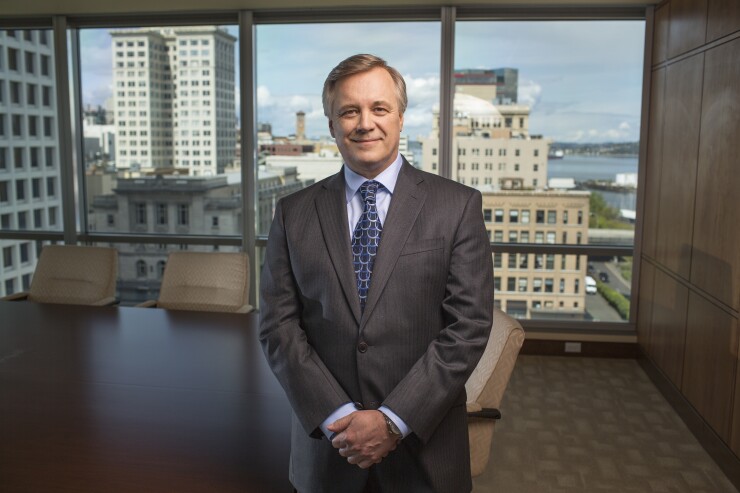Melanie Dressel made Columbia Banking System a regional powerhouse, but it is up to Hadley Robbins to preserve his predecessor's legacy and expand the Tacoma, Wash., company’s reach even more.
Robbins, who became the $12.7 billion-asset company’s president and CEO after
With Columbia squarely over the $10 billion asset threshold, Robbins must find ways to keep growing while protecting the small-bank feel Dressel cultivated during her 17-year tenure.
“This is a different size bank than what they’ve been,” said Jeffrey Rulis, an analyst at D.A. Davidson. “Do you start to outgrow that community bank feeling? The challenge is to keep that culture but become sophisticated enough to drive returns expected of a bank of that size.”

Robbins is aware of the big shoes Dressel left behind. In conversation, he mentions her frequently and fondly, recounting the ways Columbia has tried to honor his predecessor's memory while describing lessons learned after becoming interim CEO.
Members of the executive team gathered and landed on the mantra of “What would Melanie do?” to help guide them through the transition, Robbins said. They realized that Dressel would have been visible, sharing stories and reassuring the bank’s employees, he added.
“I discovered the first order of business was you have a team that is hurting,” Robbins recalled. “Your job is really to help that healing process.”
The company hosted a day of service in honor of Dressel, who was well known for her commitment to the community. More than 600 employees volunteered their time on a Saturday.
The unexpected transition also drove home the importance of succession planning, something that many bankers take for granted.
Robbins requires succession plans for all of Columbia’s leaders. Doing so ensures that the company will run smoothly if a key leader leaves while also serving as a personnel development tool, he said.

“I want people to know they’re on a [career] path,” he said. “It is very critical that you have the leadership prepared to take over.”
It helped that Robbins inherited a strong institution located in thriving markets in the Pacific Northwest. While performance may not be a concern, industry experts said they are watching to see how Robbins and his team preserve a system that values employees, emphasizes team over individuals and embraces a flat management structure.
“I’m an analyst who really values the importance of culture in an organization,” said Aaron James Deer, an analyst at Sandler O’Neill. “If you were going to lay out what is good corporate citizenship, I think they would check all of the boxes.”
A eagerness to buy into Columbia's culture factored heavily into the decision to name Robbins permanent CEO in June, Deer said. He joined Columbia when it bought West Coast Bancorp in 2013.
As Columbia gets bigger, it will become more challenging to ensure that all employees understand and maintain that culture, said Jacquelynne Bohlen, an analyst at Keefe, Bruyette & Woods. She said Robbins and his team are up to the task.
Robbins, who worked closely with Dressel as Columbia’s chief operating officer, has the right personality to lead the institution, Bohlen said. He would have been a natural successor for Dressel, though the transition took place sooner than anyone expected, Bohlen said.
“They have a great name in the Pacific Northwest and a strong reputation with employees and customers,” Bohlen said. “I think that’s an asset.”
Creating a great place to work starts with fundamentals such as respect, accountability and acting ethically, Robbins said. The company’s recent decision to raise its minimum wage to $15 an hour displays those values, he added.
To improve the customer experience, Columbia plans to make more investments in technology. Management is considering ways to integrate the company’s distribution channels and upgrade its mobile, online and treasury management systems.
“What we have today does a fine job, but we really want to try and to get as much functionality as we can,” Robbins said. “We were looking at backroom automation to help drive operating efficiencies.”
A return to bank acquisitions is a strong possibility, industry experts said. Columbia used M&A to pack on nearly $8 billion in assets between January 2010 and last November.
Columbia developed a reputation as an acquirer of choice in the Pacific Northwest largely because Dressel favored partnerships over a “slash and burn mentality” focused on being overly aggressive cutting costs, Rulis said. Still, it may take potential sellers time to feel out Robbins’s style of completing and integrating deals.
“Potential sellers may want to kick the tires,” Rulis said.
While Columbia is prioritizing organic growth, it would also consider M&A, Robbins said.
While Robbins prefers the Pacific Northwest, Columbia's newfound heft is making it harder to find meaningful deals, he said. The company would consider new markets, such as northern California, but doing so would limit its ability to reach cost-cutting objectives, he noted.
“The timing is the timing,” Robbins said. “A deal doesn’t happen because you want it to happen. … There are banks that are in contiguous markets that appeal to us based on their style of business and what we believe is a good fit.”
Robbins already had on-the-job experience handling an M&A curveball. The Pacific Continental deal, which was supposed to close by mid-2017, was delayed after a community group raised objections, Robbins said. To address the group’s concerns, Columbia developed a community advisory panel to improve communication between the bank and its communities.
Columbia is also expanding its small-business lending capacity, including its participation in Small Business Administration programs.
Over time, Robbins will put his unique stamp on Columbia and adjust the company’s course to meet the demands of the environment, industry experts said. But it is highly unlikely that he will make sweeping changes to the company he inherited.
“I think any leader over time will make a mark on an institution,” Deer said. “Some leaders are brought in because change is necessary. This isn’t that sort of case.”





